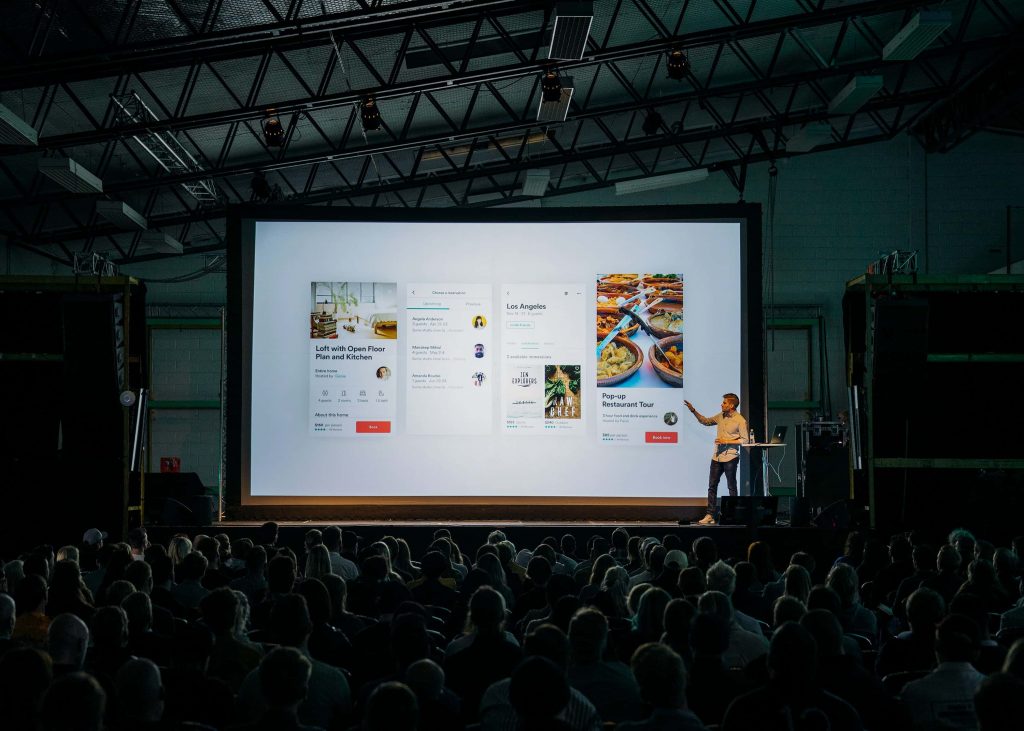
In the first part of our storytelling in business series we looked at some broad storytelling structures. But we also addressed specific circumstances where storytelling is useful internally, such as dealing with internal business change.
This week we look at how storytelling is useful in the external facing aspects of your business. Such as presentation decks, websites and even product/service pages.
So let’s continue our storytelling journey…

Storytelling In Business – External Facing Decks
If you are a B2B company, it is almost certain that you have lots of sales decks.
A sales deck is, at the moment, still a vital part of the B2B purchase funnel. In the era of self-directed consumer journeys in B2B, this may start to change. But for now we still operate with the old “about”, “pricing” and “sales” types of deck.
But have you ever seen any of these decks with a proper story arc? The number of B2B decks that use storytelling or narrative structures is rather low.
There are many ways to structure your external decks and they each offer different narrative benefits.
McKinsey, for example, has a unique approach on how to structure external presentation decks. Most of McKinsey’s structures are variations on the three-act structure popularized by Syd Field in his book “Screenplay: The Foundations Of Screenwriting”.
Syd Field’s three-act structure is split into, well, three acts. Act one is “set up”, act two is “confrontation” and act three is “resolution”. Most of the films we all love have a linear three-act structure. In Star Wars, we meet Luke, Leia, Obi-Wan, Han Solo and Chewbacca in act one. They get trapped on the death star and escape in act two and the death star explodes in act three.
McKinsey’s variant on this for its external presentation decks is the SCQA framework.
SCQA stands for:
S – Situation (eg. what things look like today, the context)
C – Complication (eg. the issue or the ask. owners want a higher EBITDA or market cap)
Q – Question (eg. how do we fulfill the ask, how do we raise EBITDA or market cap value)
A – Answer (eg. the conclusion or suggestion, we raise EBITDA or market cap by doing X, Y and Z)
Now you might say “well there are four acts there and four letters”. While yes there are four letters there are only three acts. Situation is the “set up” act. Complication and Question are the “confrontation” act with Answer being the resolution act. It follows a three act narrative arc.
The twist here is that McKinsey leads with the answer. Which is another storytelling device called “reverse chronology”, used in films like “Memento”.
This kind of narrative structure can make complex ideas and issues much more easy to digest.
McKinsey also has rules around slide titles. All slide titles have to support the overall story. If data is used, important data is highlighted. But data is never the story, it is only used to serve the story McKinsey wants to tell.
Using the three act structure and SCQA your business presentations can move away from the usual dull slides to real stories that change minds.
Storytelling Actions For Your Decks
- Use a three act structure starting with “setup”
- Provide context that serves the story
- All titles must support the overall story arc of the deck
- Use SCQA as a support for the three act structure within your deck
- Try using reverse chronology, lead with your answer
- Highlight important data only. Don’t drown your slides in numbers
- Create a format and template then STICK TO IT
- Data matters but data is not the story
- A good story changes minds, always remember that for every external deck

Storytelling In Business – Your Website
Your website is a great platform for brand storytelling. How you do that depends on what you offer and what sector you operate in.
For example if you are an ecommerce marketplace, your homepage is going to consist of your best selling products. So there may not be too much of an opportunity to craft a story in that prime position. But if you are a B2B service company, for example a moving business, your homepage is where you can really spin a great narrative.
But that does not mean that if you are a marketplace you cannot tell stories on your website. That just is not true.
But you do need to put some work in. All websites need great content, the phrase “content is king” is a cliche at this point. But if content is really king then great visuals are queen. If you want proof of that, look no further than one of the biggest brands out there; Nike.
Nike ditched selling wholesale to Amazon and, since the pandemic, 30% of the company’s sales come from direct e-commerce. So the Nike website is a global e-commerce marketplace for Nike goods.
But it does not feel like one.

Nike realizes that to tell a good story on an e-commerce site you need both great content and great visuals. The Nike homepage always has both of these things. Nike promotional graphics have a distinct vibe that reflects the brand.
Nike also has a lot of inspirational content on its blog. Posts such as this have a great human story and tie into the overall aspirational nature of the Nike brand. The “Ask The Coach” series that Nike runs on their site is a great example of how an e-commerce site can utilize human stories that complement their brand and the user’s purchasing experience.
Complement is the key word here. Your story should complement the user’s purchasing experience. If possible your design, UX and messaging should all be aligned around the story you want to tell, so it complements the user’s purchase journey. This is just as true for Nike as it is for your business. The Bagigia site is a great example of this alignment. The visuals, ux and copy all highlight the product in an interesting way. As you scroll, the messaging tells you a story about the product in a novel way. You learn about what prompted the idea, how the product is made and most of all who makes it.
If you are a B2B company or selling a service, you have even more room to experiment with storytelling. The same principles also apply. You need great visuals, messaging, ux and copy that all align with your story and the overall user purchase journey.
If we want to create better digital experiences, we really have to start thinking about websites as an experience. In the same way that visiting a theme park is an experience, or playing a great videogame for the first time is an experience. That means creating a narrative and designing content, visuals and UX that complements that narrative. This will be even more important in the future as technology advances.
Storytelling Actions For Your Decks
- Plan the story you want to tell
- Plan your visuals, copy and UX around this narrative
- Make sure the purchase journey complements this narrative
- If you are a marketplace use support content to tell more stories like blogs, videos etc
- If you are in B2B you can still tell stories, if anything you have more room on pages like your homepage
- Think of your website as an experience in the same way visiting a fancy restaurant is an experience. It’s not just converting quicker and call to action text
- This will elicit emotion from your customers, which will drive more purchases/interest

Storytelling In Business – Product Pages
If you run an e-commerce marketplace website, all of the above practices hold true even on your product pages. But there are some subtle differences you have to take into account. While you need to stay aligned to your overall story, you also need to create a product narrative.
A product narrative is different from your story. Your story, for example, might follow a three act structure with setup, confrontation and resolution. A product narrative may not have that. What a product narrative has to have is messaging and imagery that gives the customer the right perception of the product you are selling. For example, if you sell televisions you could just put the product spec on the page, how big the screen is. But you could also have more persuasive copy, telling the customer about the “vivid colors” and “immersive sound”. That is a product narrative. A product narrative is designed to make a product more attractive beyond its obvious attributes.
Apple does this very well. You can see on their iPhone 13 page that they describe features but in an accessible way that is not boring to the average consumer. The statistics and facts are still there for people that want them, but the product copy is simple, clear and aspirational.
The same rules hold for B2B service websites. You need to be able to communicate your offering in simple and clear language. Now, your target audience in B2B may expect a certain amount of technical jargon. But try to keep it to a minimum and make sure it’s in service to your overall story on your website. Be sure to guide leads with a good story and direct them to get in touch with you. When they do, make sure you use the same tone of voice as on your website, at least initially.
Storytelling Actions For Your Decks
- Create a product narrative
- Give the customer the right perception of your product/offering with the right language and visuals
- Use attractive, but simple, language
- For B2B companies use language your audience wants (but try to cut down on jargon)
Read on for part 3 where we will (finally) dive into storytelling in marketing!

Talk to MAQE
Need to create real experiences on your online and offline channels? Commerce experiences that make customers feel something? Talk to MAQE. We are commerce experts who have been around for a long time now and we have worked with huge brands in different industries. Get in touch via [email protected].
